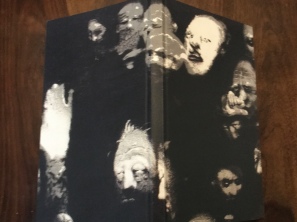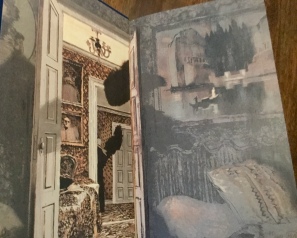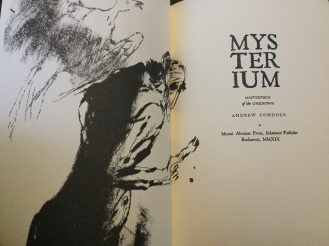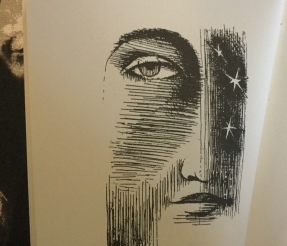MYSTERIUM – Andrew Condous
MYSTERIUM: MASTERPIECE OF THE UNKNOWN
Mount Abraxas Press, Isolationist Publisher, Bucharest MMXIX
My previous reviews of Andrew Condous: https://dflewisreviews.wordpress.com/tag/andrew-condous/ and of this publisher: HERE
When I review this book, my thoughts will appear in the comment stream below…






Mine numbered 4/63.
“; a village where day disintegrated at its core and night disintegrated at its edges;”
“…when he crossed the portal of his open eyes and ventured into this world.”
A story of village – and city (Bucharest) – and its Pareidolia and Apophenia of all the themes from 2009 that Mount Abraxas/ Ex Occidente has touched upon from outside or claustrophobically lurked within, here incredibly distilled as an arcane and ancient apotheosis of wordiness that is so utterly utterly wordy it also becomes wildly avant garde!
I cannot convey its effect otherwise. A complex rapture.
“At times, I would come across a book, invariably one that had come from the small publishers of the capital… […] …written with the language of dream.”
Pages 17 – 20
“, a shadowless frozen spectre. It was he.”
I seem now to be in Bucharest itself among various avant-gardists, in a more accessible but still satisfyingly textured wordiness, in incredible visions of a genius loci and a meeting that only happens rarely. Here it was he. If only it were me.
“I erect memorials to catastrophe and epitaphs to nothingness.”
These pages represent my most significant reading experience as a short burst of inspiration for some while, and the amazingly external and self description of the character whom I meet in it reveals a far better gestalt real-time reviewer than I shall ever become. And the described bookshop that leads to mention of Scriabin’s Mysterium can surely only accentuate that fact.
“You will also encounter strange patterns and traceries that will reside within these fictions and you must not dismiss or ignore these, for they will be the disguised lines of reality. […] …a mysterious, singular and unprecedented wholeness that will encompass your being.”
“I sit in the dust with my back leaning against the church wall, surrounded by bouquets of rubble, waiting for his arrival.”
A travelling from the previous scenario with followed or following personage towards a tunnel vision, or, rather, a visionary tunnel, with an exquisite version of Slawomir Wielhorski ruinenlust. This book, you know, seems, so far, rather special and worth reading first thing Christmas Day.
Pages 34 – 37
“What is most peculiar is not the lack of windows but the building’s shape, an application of a strange geometry that seemingly gives it the features of a partial fiction.”
From the tunnel to a mansion in Bucharest (book-a-rest), one that is remarkably textual in this book and, I infer, restfully prehensile. Towards a garden that lives and breathes as if one in Dead Astronauts, and stones of various “shades of grey.” If you read these Condous passages and Dead Astronauts, you will know what I mean. Each preternaturally feeding off the other, inadvertently if simultaneously.
Pages 37 – 40
“I have always found it recondite as to why trees or flora of most kinds, have a necessity to have height and depth diverging from them to every compass-point, why they must have two mouths.”
Still becoming the narrator, we follow him, and we study a tree and then the first two of five statues. This text is definitely an important one, now transcending avant-gardism with the accessibility of meticulous passion. Descriptions that are quite extraordinary but ones we can truly understand somewhere in the seat of our soul. So many quotable quotes. I have to restrict myself to only two in this section of pages.
“A confusion of partialities that nevertheless carry an implicit wholeness.”
“; it was as if an unexpected metamorphosis had taken place and the imaginer transformed into the imagined.”
And this book transformed into Dead Astronauts, and vice versa, with neither book possibly knowing the other because they were first published at the same time. I believe that you will never forget the descriptions of these statues, five or arguably six, if you include the narrator, or 7 if you then add the tree. And many thanks for the introduction to the sculptor Dimitrie Paciurea.
I can’t wait for the narrator to enter the mansion after viewing these statues.
“Not a ruin pushed by time, but something that cannot be properly experienced or seized, something that is moved through, unfelt yet absorbed. Before me is a space deformed by the unusual internal structure imposed by the external architectural skin, with each section seemingly drawn into the other, causing the furnishings and fixtures to be linked by unfamiliar distances.”
I was not disappointed by the narrator’s entry into the mansion, a whole new ultra-textured pattern of Ligottianisms, a mannequin vision, after blending the Wielhorski ruinenlust that I mentioned above, John Howard’s Tower of Yeats that I read a few days ago here, and Tweddell’s concurrent entry into an equivalent ‘mansion’ by Leo here when seeing an unexpected trapdoor as unverified by his earlier memories. That quote I give above from the Condous is not even the best of many mind-staggering quotes I could have quoted from this section of pages!
I drift ecstatically with the Hawling of “dream pulleys”, “capturing fragments”, “a cubist perspective” on conversations and debates featuring,
perhaps significantly, Mateiu Caragiale, “eyes tunnelling me”, “artificial ghost generation”… And mascarons reminding me of this work by Mark Valentine: https://nullimmortalis.wordpress.com/2010/08/24/the-mascarons-of-the-late-empire-other-studies/ and this very Christmas period’s TV production of Dickens’ CAROL, as we delve deeper into the mansion.
Into a room, whence its exit is another door indistinguishable from the rest of the wall. Well, I am disturbed by the inspiration I get from exhibits like skulls or skeletons that could be sculptures or statues, and mirrors that create this teratism of self. My self. “…which motivate an urgent need to commence litigation against the gods.” And Romanian art, surrealism, avant garde, Sesto Pals, Gherasim Luca — please also see this important book by the same author: https://dflewisreviews.wordpress.com/2014/03/06/letters-from-oblivion-andrew-condous/
And pattens of gestalt real-time-time reviewing…
“They are encased in a mixture of time, a mix of pastness, presentness and possibilities of the future.”
DEFLOWERING OF MASKS
“the architecture of voids is prevalent in Romania today”
It is ironic that this book is, for me, a depiction of a gestalt real-time reviewer in a way so utter, it has been a revelation towards the religion that awaits us all who can enter various doors of this art of the preternatural that is literature. It is pointless my trying to impart further how this book conveys such rarefications of rarefiction. Ironically, as I find, weakening the ability to gestalt real-time review it at the same time as strengthening that ability! Like Scriabin’s Mysterium, a work-in-progress. And endless striving for an elusive gestalt. Appropriate perhaps that this is my first completed real-time review of 2020. A time to ‘revisit intentions’, as it puts it? That fracture of time. My own pretentious smile.
“a species of oblivion that even death did not share.”